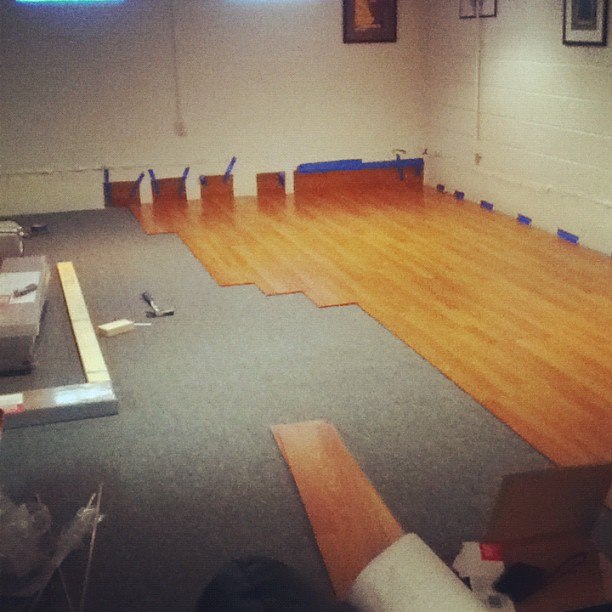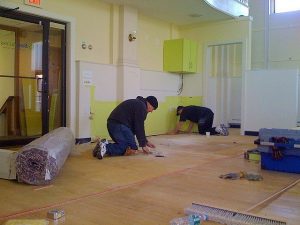Dancers can be pretty picky about the surface they dance on. I can understand that, having a daughter who is a professional ballerina and having been a bit of a dancer myself, when I was younger. Dancing on the wrong sort of surface can be extremely dangerous, to the point of causing some serious injuries; and the more complicated the dancing is, the more important a good floor is. Like I said, I know and I’ve got the surgery scar on my knee to prove it.
While there are a number of man-made materials out there, which have been developed for use in making dance floors, wood is still considered to be the best. As expensive as a wood dance floor can be, it’s actually cheaper than buying some of those special materials. So unless the dance floor is going to be in a professional studio, it really makes more sense to make the floor out of wood.
What makes wood so good as a dance floor is that it gives a little. This is important to protect knees, ankles and other joints. A hard floor, without any give, like ceramic tile or concrete covered in linoleum, is going to be much harder on the dancer’s knees and ankles, especially in the case of ballerinas.
But just how is that done? What does it take to make a usable dance floor?
A lot of the answer to that question depends on the type of floor that is desired; specifically where it is going to go and how it is going to be used. If the dancer that’s going to be using the floor is just practicing their tap dancing, then a 4’ square piece of plywood will probably be enough. On the other hand, if the dance floor is for a party in the backyard, a whole lot more is required.
Another consideration is whether the plywood itself is going to be the dance floor or it will be the subflooring, with something else put on top of it. Ballet, ballroom dancing and even country-western dancing really should be done on a wood floor; but that isn’t required for all types of dancing. Some types are better performed on a softer surface.
Choosing Plywood for a Dance Floor
Since the dance floor is going to be made out of plywood, the type of plywood chosen is important. That, in turn, will have something to do with what sort of floor covering, if any, is going to be put on top of the plywood. If the plywood is going to be used without any floor covering installed, then sanded softwood plywood is ideal, such as an AB or AA sheet of ¾” plywood.
On the other hand, less expensive plywood can be used if anything is going to be placed over the plywood as a floor covering. This includes hardwood strips, composite strips or linoleum tile. In such cases, either construction grade CDX plywood could be used or OSB.
Regardless of what sort of plywood is used for the dance floor, it needs to be “sprung.” This means applying some sort of backing to the plywood, to act as a support and provide additional cushioning for the dancer’s knees and ankles. There are two basic materials which are commonly used:
- foam panels – the same sort of interlocking foam panels which are used for factories and workshops, providing a softer surface to stand on than concrete.
- wood strips – a framework of wood strips both provides additional stiffness and support to the plywood panels, as well as raising them up off the floor, so that the wood can flex.
Wood strips are necessary on larger, portable dance floors, as they provide some means of connecting the various floor panels together.
Dance Floor for Practicing Tap
The simplest form of dance floor is one used for practicing tap dancing. The main reason a dance floor is needed in this case isn’t to protect the dancer’s knees, as it is to protect whatever flooring is in the house. Taps on shoes can scratch up flooring rather severely, so a plywood floor is used to practice on.
A simple sheet of plywood, cut in half to make a 4’x 4’ panel can be used as a dance floor for practicing tap. This is big enough for practicing most steps in tap. Adding a backer to spring the floor isn’t even necessary, although it is a good idea.
Semi-Permanent Dance Floor for Dance Practice
Ballet, ballroom, country western and other types of dancing require much more space than tap. That probably means having a fairly large area in the home converted into a dance floor, perhaps even a whole room. Doing this to a family room wouldn’t make it impossible to use the room for other purposes. It would just be necessary to avoid putting too much furniture in the room, as that would limit the space available for dancing.
In this case, since the floor is semi-permanent, the best way to start out is by building a framework on the floor out of one or two inch thick dimensional lumber. One inch thick is enough to spring the boards, but two inch thick material will be stronger. It only needs to be wide enough to attach two adjoining pieces together, so 1”x 2”s will work. To avoid having to put hole in the floor, put the framework together using screws and angle brackets.
The plywood should be attached to the framework with screw, ensuring that the screw holes are countersunk, so that the heads of the screws are below flush. A protruding screw head can be very dangerous, either in providing a trip hazard or by being a cut hazard if someone falls on it.

Portable Exterior Dance Floor
The hardest type of dance floor to make is a portable one, especially if it is going to be used outdoors. There are two basic problems here. The first is that the ground is most likely going to be uneven, so the floor has to have the ability to bridge high points, creating a level area for dancing. The second is that the individual plywood panels have to be connected together somehow.
In order to do this, a wood framework is needed, under the plywood. This can be made of anything from 2”x 3”s to 2”x 12”s, as desired. Just keep in mind that the higher the dance floor is, the heavier it will be to move and the more space it will take to store it. Most people use 2”x 3”s or something similar for this reason.
Build the framework, just like for a floor, and then attach the plywood to it with screw or nails. In this case, it would be a good idea to glue the plywood to the supporting structure as well, so that the plywood does not separate from the structure after moving it.
The big problem here is attaching the various 4’x 8’ pieces of flooring together. There are a couple of different ways of doing this without having to buy special hardware. The first is to drill through adjacent frame pieces and bolt the pieces of flooring together. This works well, if there’s a large crew of workers available to flip the floor over, once it is bolted together.
The other option is to attach blocks to the outside corners of the floor sections, through which the floor will be bolted together. With this system, there is no need to flip the floor over, once it is bolted together. But it only takes care of the perimeter of the floor. So it should be used in conjunction with some sorts of pins, such as mortise and tenons, which hold adjacent pieces of the floor together.
Finishing the Floor
If the plywood is going to be the flooring, then it should be finished with varnish to protect it and to keep splinters from coming off. If there are any voids in the surface, they need to be filled with a wood putty that is rated for flooring. Don’t use normal wood putty, as it will not hold up.
Vinyl, hardwood flooring or composite wood flooring can be mounted to the plywood for flooring. Keep in mind how the floor will be used and select a floor covering which will be conducive to that sort of dancing. When in doubt, ask a dancer.



